Disaster Management: Responding to Disasters - Disaster Response | 9th Social Science : Geography: Disaster Management: Responding to Disasters
Chapter: 9th Social Science : Geography: Disaster Management: Responding to Disasters
Disaster Response
Disaster Response
Disaster response entails restoring physical facilities,
rehabilitation of affected
population, restoration of lost livelihoods and reconstruction efforts to
restore the infrastructure lost or damaged. The Response
Phase focuses primarily on emergency
relief: saving lives, providing first aid, restoring damaged systems
(communications and transportation), meeting the basic life requirements of those impacted
by disaster (food, water
and shelter) and providing mental health and spiritual support
and care.
Who are the first responders?
No matter how large or small, local
communities are expected to
provide immediate disaster response. On a daily
basis, police officers, firefighters, and emergency medical technicians are a community’s first
responders, whether during
fire, flood or acts of
terrorism. Mental health
professionals and the community’s hospitals may also be
activated in those early minutes
and hours after disaster.
Disaster management includes Prevention, Mitigation,
Preparedness, Response and Recovery. Disaster management involves all levels of
government. Non- governmental and community based
organizations play a vital role
in the process. Modern disaster management goes
beyond post-disaster assistance. It now
includes pre- disaster planning and
preparedness activities,
organizational planning, training, information management, public
relations and many
other fields. Crisis management is important, but is
only a part of the responsibility of a disaster manager.
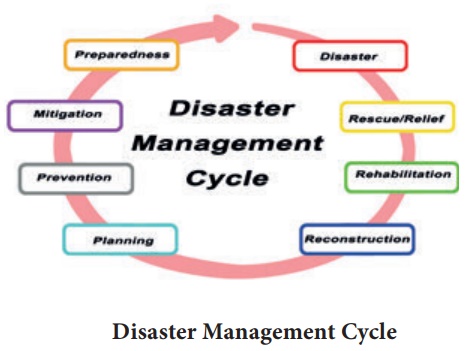
Disaster Management Cycle The traditional approach to disaster
management has a number of phased sequences of action or a continuum. These can
be represented as a disaster management
cycle. We mainly focus on the way
how the community should
respond to disasters.
Earthquake
An earthquake is a sudden
vibration of the part of the earth caused by plate
movements. It occurs along the plate
boundaries. The place inside the earth where an earthquake originates is focus.
The point on the earth’s surface
above the called a focus is called an epicentre. The damage caused by the earthquake is the highest
near the epicentre.
The earthquake is measured by an instrument called a Seismograph. It is recorded in Richter scale. Let us now see how the communities can better respond to earthquakes.
How to respond to earthquake?
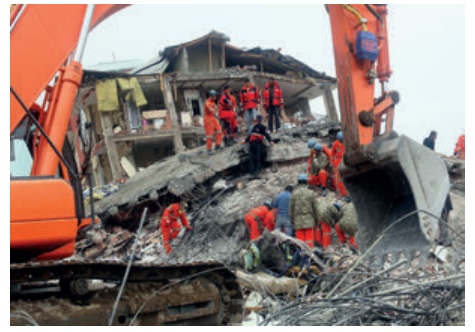
What to do during an
earthquake?
Be aware
that some earthquakes are actually foreshocks and a larger
earthquake might occur later. Minimize
your movements to a few steps
that reach a safe place
nearby and stay indoors
until the shaking
has stopped and you are sure exiting is safe.
If indoors
1.
DROP to the ground; take COVER by getting under a sturdy
table or other piece of furniture
and HOLD ON until the shaking
stops. If there is no table or desk
near you, cover your face and head with your
arms and crouch in an inside corner of the
building.
2.
Protect yourself
by staying under the lintel of
an inner door, in the corner of a room, under a table or even under a bed.
3.
Stay away from glass windows, outside doors and walls and anything that could
fall (such as lighting fixtures or furniture).
4.
Stay inside until the shaking stops and go
outside.
If outdoors
1. Move away from buildings, trees, streetlights and utility
wires.
2.
If you are in open space,
stay there until the shaking
stops. The greatest danger exists directly outside buildings at exits and alongside exterior walls. Most
earthquake- related casualties
result due to collapsing walls, flying glass and falling
objects.
If in a moving vehicle
1.
Stop as quickly as safety permits.
Avoid stopping near or under buildings, trees, overpasses and utility wires.
Proceed cautiously once the earthquake has stopped. Avoid roads, bridges or ramps that
might have been damaged
by the earthquake.
Tsunami
A tsunami can kill or injure people and
damage or destroy buildings and infrastructure as waves come forth and
recede. A tsunami is a series of
enormous ocean waves
caused by earthquakes, underwater
landslides, volcanic eruptions or asteroids. Tsunamis can travel 700-800 km per
hour, with waves 10- 30 meter high. It causes flooding and disrupts
transportation, power, communications, and water supply.
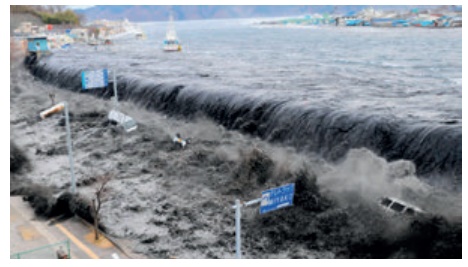
How to respond to Tsunami?
1.
You should find out if your home, school, workplace or other
frequently visited locations are in tsunami hazard areas along the sea-shore.
2.
Plan evacuation routes from your
home, school, workplace, or any other place
you could be, where
tsunamis poses a risk.
3.
Use a weather
radio or stay tuned to a
local radio or television station to keep informed of local watches and warnings.
4.
Discuss tsunamis with your
family. Everyone should be aware of what to do when tsunami strikes. Discussing
tsunamis ahead of time will help
reduce fear and save precious time in an emergency. Review flood safety and precautionary measures with your family.
What to do after a Tsunami?
1. You
should continue using a weather radio or staying tuned to a Coast Guard
emergency frequency station or a local radio or television station for updated
emergency information.
2. Check
yourself for injuries and get first aid if necessary, before helping injured or
trapped persons.
3. If
someone needs to be rescued, call professionals with the right equipment to
help.
4. Helppeople
whorequire special assistance, like Infants, elderly people, those without
transportation, large families who may need additional help in an emergency
situation, people with disabilities, and the people who care for them.
5. Stay
out of a building if water remains around it. Tsunami water, like floodwater,
can undermine foundations, causing buildings to sink, floors to crack, or walls
to collapse.
6. Check
for gas leaks. If you smell gas or hear a blowing or hissing noise, open a
window and get everyone outside quickly.
Riot
Though riot may
seem dramatic,
an angry mob can be just as dangerous
and unpredictable as just about any natural disaster. Thousands of
people are killed in riots all over
the world each year, and these riots erupt from a number of racial, religious, economic, political, or social causes that
cannot be predetermined. As per Pew
Research Center analysis of 198 countries
on April 11, 2015. Syria tops in riot in the world followed by Nigeria,
Iraq and India.
If you've found yourself
in the middle of a riot, you may not be able to run
away immediately, but you
can take some measures
to protect yourself
from harm. If you want
to know how to survive a riot, just follow these
steps.
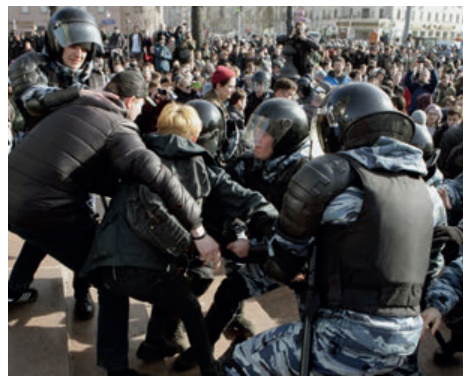
Surviving a Riot
At Travel Destination: What to Do
1. Keep
abreast of the current news if you are in a volatile area.
2. If
you come across a demonstration, don't become inquisitive, just leave the area
and find another route to your intended destination.
3. Avoid
any place where police or security forces action is in progress.
If caught in a riot:
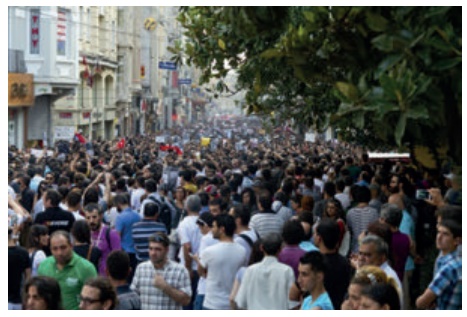
1. If
you find yourself caught up in a demonstration, keep to the edge of the crowd
where it is safer. At the first opportunity, break away and seek refuge in a
nearby building or find a suitable doorway or alley and stay there until the
crowd passes.
2. When
leaving the fringe of the demonstration, just walk away – don't run as this
will draw attention to you.
3. In
the event that you are arrested by the police/military, do not resist. Go along
peacefully and contact your law advisor to help you resolve your predicament.
4. If
you are caught up in the crowd, stay clear of glass shop fronts, moreover, move
with the flow.
5. If
shooting breaks out, drop to the ground and cover your head and neck, and lie
as flat as you can.
Fire
Wildfires occur when vegetated areas are set alight and are particularly common during hot and dry periods.
They can occur in forests,
grasslands, bush and deserts, and with blowing
wind, can spread rapidly.
Fires can lead to the destruction of buildings, wooden bridges
and poles, power, transmission and telecommunication lines, warehouses containing oil products and other
fuel. It causes injury
to people and animals.
The most common causes of fires are lightning strikes, sparks
during arid conditions, eruption of
volcanoes and man-made fires arising from deliberate arson or accidents.
A side-effect of wildfires which also threatens inhabited areas is smoke.
Fires create large quantities of smoke, which
can be spread far by wind
and poses a respiratory hazard.
On an average,
in India, every year,
about 25,000 persons die due to fires and related
causes. Female accounts for about 66% of those killed in fire accidents. It is estimated that about 42 females and 21 males die every day in India due
to fire.

Fire Safety Do’s and Don’ts
1. Know
your building’s evacuation plan.
2. Evacuate
calmly and quickly, whenever a fire alarm or carbon monoxide alarm sounds.
3. Before
opening a door, feel it with the back of your hand. If the door is hot, do not
open it.
4. If
you encounter smoke during your evacuation, stay low to the floor.
5. Know
the outside rally point for your building.
6. Know the locations of fire extinguishers, fire alarm pull stations and exits.
What you should do during a fire:
1.
Stay calm.
2.
Pull the
nearest fire alarm
or call 112.
3.
Give your name and location of the fire.
Do not hang
up until the police dispatcher tells you to do so.
4.
Leave the
building immediately.
5.
Inform others as you pass them to leave the building immediately.
6.
Walk—don’t run—to the
nearest exit.
7.
Never use elevators—an
elevator may become a trap.
Related Topics